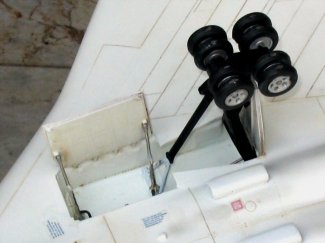|
The mighty Vulcan
was the mainstay of the RAF long range strike force for many years from the late
1950's until the early 1980's. Maintaining a high level nuclear deferent,
maritime patrol, low level strike/attack and aerial tanker all became
roles for the Vulcan during its service life. However it will probably be
remembered for the longest operational bombing mission in history (Ascension
island to Port Stanley in 1981) and as one of the most spectacular airshow
performers of all time. I'll never forget the "Bomber flypast" at RAF
Fairford in 1989 with the B-52, KC-135 and F-111 flying past in a level Vic at
500' and the Vulcan taking off and climbing through the formation
at 45 degrees, later to decend and join up in finger 4 on the other side of the
field. Fantastic.
|
Click on
images below to see larger images
|
|

|
 |

|
This is the very
hard to find Aeroclub kit. Produced in the mid 1980's only 400 were made and
apparently it almost sent Aeroclub bust. That would have been a double tragedy.
Although I searched Ebay etc for ages I eventually got mine from a simple post
on Hyperscale and I had a the kit in my hands within weeks.
As can be expected
by such a large vacform, it was a bit more demanding than the average kit.
Suffice to say it took me from March to December 2004, a time I would normally
have built 6 or 7 other kits. The challenges were typical of any vacform kit
only bigger. Minor variations in alignment of the undercarriage bay would
lead to huge variation of the wing tip height. Not easy as you have to fit the
bays before fitting the wings! Keeping it all square and having 18 wheels on the
ground at the end were the main issues. This was not helped by
the lack of a spine. Everything had to be measured relative to something else so
if one part was out then errors got magnified until something wouldn't fit and
all had to go back to square one. If I did it again (!) I would build and
internal frame from Aluminum tube and hang everything off that. This would also
help from the weight perspective as the final model is over 1Kg. Having all
that weight supported on 3 legs meant the structure needed to be
strong as well as accurate. A new dimension in modeling. I won't go
into detail of the build as the kits are few and there was a good article in SAM
in 1983 (Thanks Darius for a copy). I decided to do the interior for my own
interest sake. You can actually see it with the canopy removed although my
camera is not good enough to get a picture.
I originally planned
to open the weapons bay so cut it out and detailed top, front and rear.
However about halfway through, and after much deliberation, I chose the
original white scheme based on the original role of the Vulcan in high
level nuclear strike. For this I needed a Blue steel missile scheme and a closed
weapons bay. Due to age and bad storage, the decals were quite poor so this
helped the choice of scheme. The kit got about 3 coats with "Mr Surfacer
1000" spray bombs and then was painted overall with a mix of Mr Colour
"Character white" and normal "White". The national
markings were masked and sprayed with colours based on those of my Dynavector
TSR2. The stencils were necessary to break up the monotony of the white but the
decals were printed dark for the camouflage schemes and carrier film had
gone brown and looked awful. I hit on a novel idea of using the decals and then
spraying lightly over them with the base colour. This toned down the
lettering and hid the carrier film. The serial for the fin was printed onto
decal paper on my PC.
|
Click on
images below to see larger images
|
|

|

|

|
There are plenty
of photos of white vulcans but the plane tends to be over exposed so weathering
effects are hard to gauge. I based the weathering on the cover photo on the book
"The Vulcan Story 1950 to 2002" which was a valuable source of
info for detailing wheel bays and determining which planes had the series 300
engines of the kit. The chosen plane XM594 served in the UK and Cyprus
before retiring to the Newark Air museum where she sits today in the grey Green
scheme.
|
Click on
images below to see larger images
|
|

|

|
Thanks Aeroclub for
a superb model and Peter Vanderschaff & Mark Davies for their ever useful
contributions.
Reference to
"Vulcan Last of the V bombers" by Ken Ellis
"The Vulcan
Story 1950 to 2002" Tim Laming
Colin
|